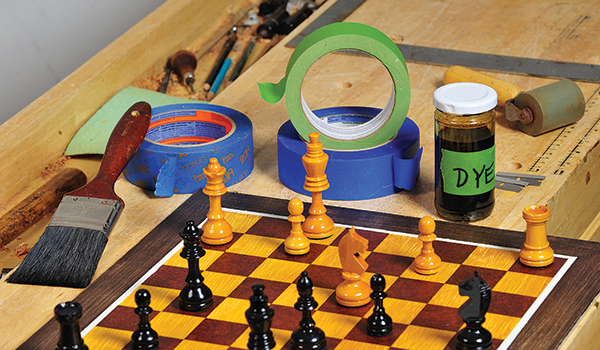
Instead of gluing up contrasting blocks of wood or veneer to create a chessboard, you can do it with just dye, stain or paint, and masking tape. Applying masking tape isn’t challenging, but there are a few tips that might just make the job easier and, more importantly, neater. Let me share what I think are the best tapes, tools and techniques.
Before You Tape
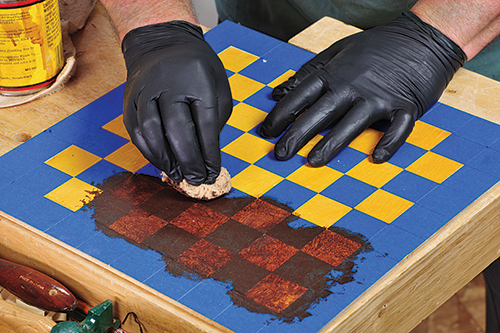
It’s often wiser to dye, stain or seal the wood before you mask. For instance, you might start with a dye or stain for the lighter colored squares. Flood dye over the entire surface and wipe it all off immediately. When it’s dry, seal it with a coat of dewaxed shellac to prevent bleeding. Once that’s dry, mask every other block, then color the open squares with a darker pigment stain or contrasting paint color.
For paint over paint, apply the lighter paint color over the entire surface. Once it’s dry, mask and apply the darker paint over the first. On fresh paint, use delicate surface or low-tack masking tape.
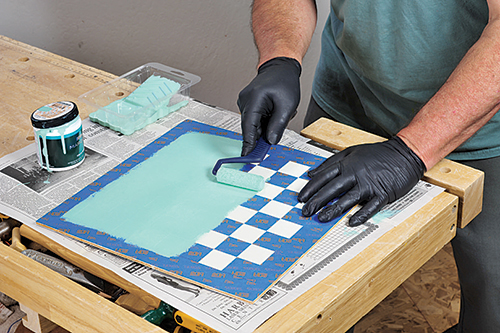
Dye will creep under any sort of tape, since it goes through the wood itself. To get a crisp edge with dye, you must seal the area underneath the masking tape first. It means taping twice, but it’s worth it. Tape the area that will be dyed, then seal the adjoining areas with dewaxed shellac. After it is dry, reverse the taped and untaped areas before applying water-soluble dye.
Working with gold or silver leaf? Start by creating a filled-pore, high gloss finish over the entire surface in the color of the non-leaf blocks. Mask, then apply gilder’s varnish, also called gold leaf size. When it is dry enough to squeak, apply the gold or silver leaf and rub it with a clean, dry cloth before removing the masked squares.
Choose Your Tape Wisely
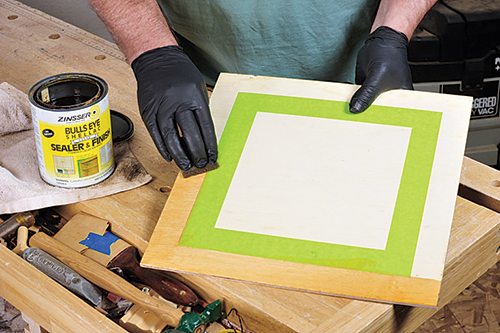
Not all tapes are equal in all applications. For lacquer, shellac, or oil-based materials, I prefer Scotch™ green lacquer tape, more common in auto parts stores than home stores. For water-based, you’ll get clean edges with Scotch Edge-Lock™ tapes (blue) or FrogTape® (green). These are designed to stop water from seeping under the tape, and they do actually work quite well. In a pinch, regular painter’s tape will work.
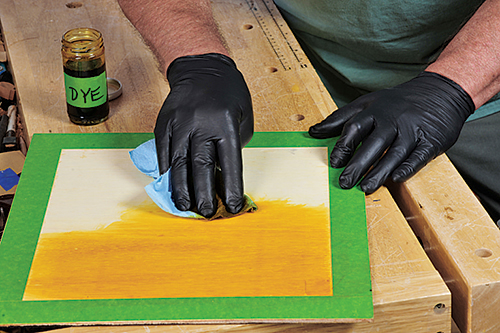
For paint-over-paint masking, use delicate surface or low-tack tape, which is less likely to lift the recently applied paint. Because it has lower tack or grab, make sure to smooth and press down the edges carefully after affixing it. When masking over paint, give the base color at least 24 hours to dry before masking, even when using low-tack tape.
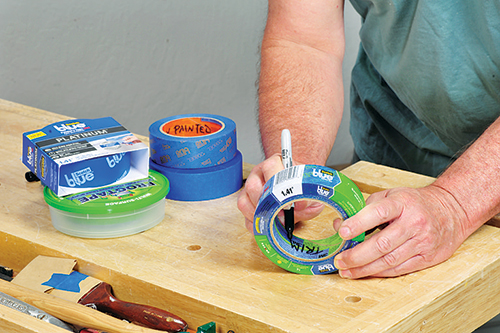
You’ll notice I have not mentioned the traditional beige masking tape. My advice is to avoid it completely, as it yields sloppier lines and does not peel off either cleanly or easily. Apply the tape without wrinkles, then press the edges down with a brayer or squeegee. For a crisper line, let the tape sit in place overnight before you paint or stain.
Waste Tape, Save Time
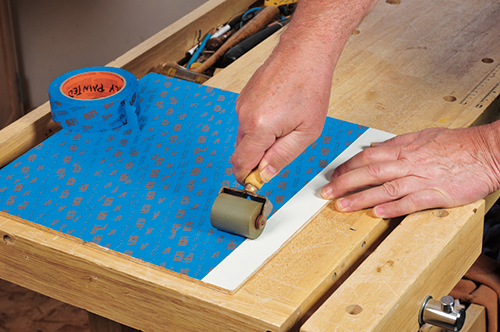
What I’m about to describe may seem odd, but there’s method in my madness. For something like a chessboard, I’ll use wide rolls of tape and cover the entire surface rather than creating 64 blocks with many small pieces of tape. Abut the tape edges carefully, leaving no spaces whatsoever, but avoid overlapping. Sometimes using more tape and a sharp razor can actually save you time. The three photos show how that works.
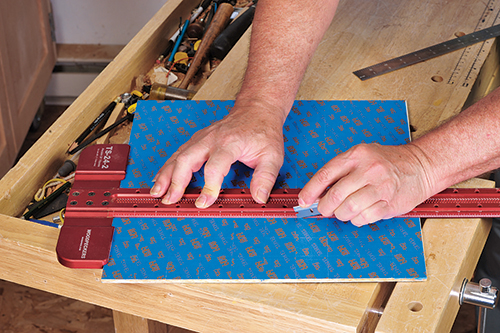
Even at best, the tape edge will form a dam where paint or stain can well up and form a ridge. We want to keep that to a minimum, and thicker overlapped points make it worse, in addition to creating small spaces where finish can creep under the intersection.
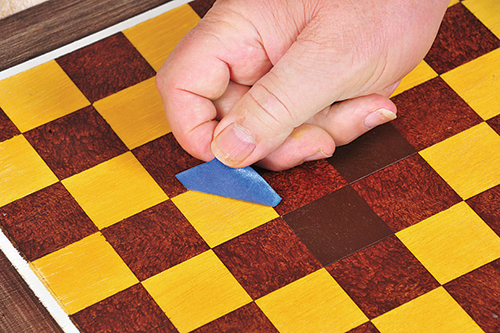
Now that you have an unending sea of tape, use a straightedge and sharp razor blades to cut your chess block squares, then peel off every other one. I buy boxes of 100 single-edge razor blades at the home store for just a few dollars, and switch to a new, sharp one frequently. Don’t worry if you cut through into the wood as well, since it will barely show, and it may even make the chessboard look more like cut blocks or veneer. After all, that’s what we are trying to mimic.
Small Dams, No Puddles
Try to brush your paint or stain away from the masked edge and towards the center. Dragging the brush over the edge of the tape will form a puddle of excess paint at the edge, which dries slower, chips more readily and leaves an unpleasant ridge of paint.
Miniature paint rollers actually work better than brushes on masked surfaces, since they apply paint more evenly and don’t scrape across the tape dam. Using stain? Daub instead of scrubbing or wiping, if possible.
Removing the Tape
Don’t just pull upward to remove tape. Start at a corner or edge and pull the tape back over itself at an angle away from the painted edge. This will give you a cleaner line with less paint lifting.
To level the blocks, build up several coats of non-amber clear finish, sand without going through to your color layer, and repeat. For water-based paint and stains, use water-based clear finish, which is already colorless.
Don’t Forget the Border
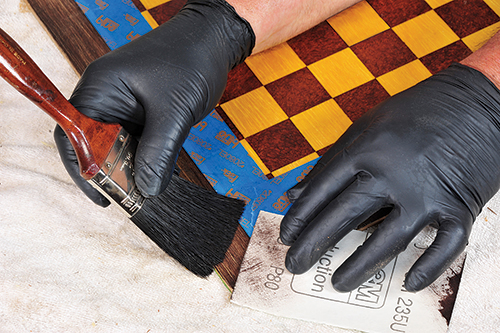
These same techniques work to create a mitered border around the chessboard. You can even add a stringer of contrasting color just inside the border. My favorite technique for glazed mitered borders is to apply gel stain atop a sealed surface, then add grain texture by dragging a dry brush through it.
Lay a piece of 80-grit sandpaper at 45˚ on the corner, grit side down. The coarse grit won’t smear the glaze. Start with the bristles on the paper and drag the brush away from it, through the stain. Move the sandpaper to the grained side to create the adjoining miter edge.






